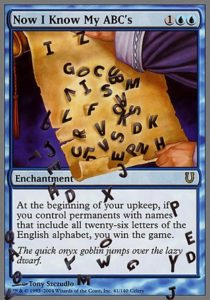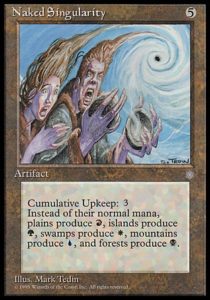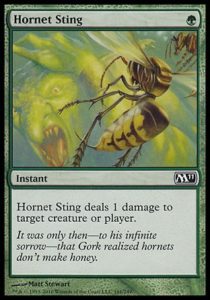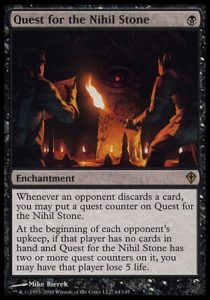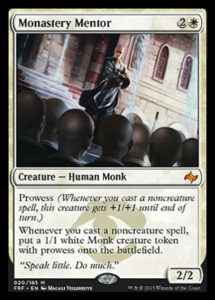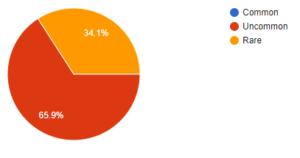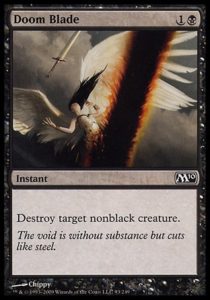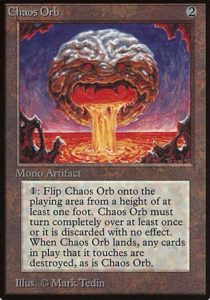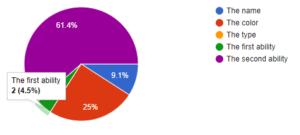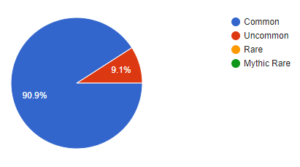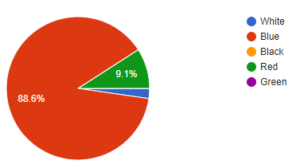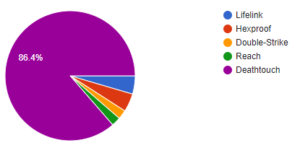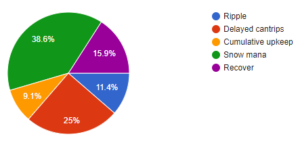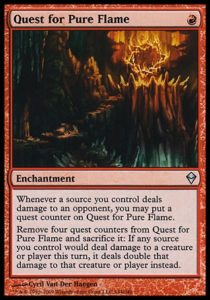Happy holidays, everyone! We’re more than halfway to the beginning of the third Great Designer Search and hopefully have some time off to relax and practice game design!
As ever, here’s the link to this week’s questions. We’ll start with this week’s challenges, then address last week’s.
Callback Assignment: GDS2 Question 46
A slim majority of respondents from the GDS2 got this correct. It asks once simple questions: how well do you know your psychographics?
46) Which of the following cards is least a Johnny card?
a) Clone
b) Devastating Summons
c) Fauna Shaman
d) Mortician Beetle
e) Near-Death Experience
Research Assignment: The Color Pie
The color pie is part of Magic’s golden trifecta (along with the mana system and the concept of a TCG). It performs the invaluable role of distinguishing the colors, ensuring that each color has personality, philosophy, strength, and weakness. However, the color pie is not stagnant; it shifts over time.
Sometimes, abilities bleed into other colors in a fitting locale. For example, New Phyrexia saw life loss (which only black does) bleed into the four colors in cards such as Vapor Snag and Inquisitor Exarch.
Sometimes, abilities change colors. Prodigal Sorcerer‘s effect is no longer blue, but red (one of the few permanent shifts from Planar Chaos).
Sometimes new abilities are created that must then be put into the color pie. Scars of Mirrodin introduced Proliferate which had to be put into the color pie. Proliferate is on six blue cards, two black cards, one red card, one green card, four artifacts (including one version of Everythingamajig), and Atraxa, Praetors’ Voice. Proliferate is presumably primary in blue, secondary in black (black has it on two commons), and tertiary in red and green (with some wiggle room).
For this assignment, I want you to consider how the color pie has changed in the last five years. Look over cards from now back to Return to Ravnica and find three different instances of the color pie changing (either due to the above reasons, or others of your choosing).
Full credit for this question goes to Carrie O’Hara. I loved it so much it couldn’t save it for later.
GDS-esque Questions
Question #1: One of the following abilities is given to a creature of unspecified color. Which ability will most likely increase the creature’s mana cost by one mana?
a) Flying
b) Prowess
c) Vigilance
d) Double Strike
e) Reach
Question #2: One of the following abilities is given to a creature of unspecified color. Which ability will most likely increase the creature’s mana cost by one mana? (That’s right, this is the same question, but with recent non-evergreen keywords.)
a) Embalm
b) Devoid
c) Afflict 2
d) Explore
e) Fabricate 2
Question #3: Which of the following mechanics can best be balanced by mana cost?
a) Dredge
b) Cascade
c) The Urza’s “free” mechanic
d) Storm
e) Delve
Question #4: Which of the following planes would be most difficult for Magic to revisit in a Standard-legal expansion?
a) Mercadia
b) Kamigawa
c) Rath
d) Ulgrotha
e) Ravnica
Question #5: Lore question! Which of these planeswalkers is currently alive?
a) Xenagos
b) Vronos
c) Koth
d) Freyalise
e) Elspeth Tirel
Design Challenge
1: New Vanilla
Design a common french vanilla creature for a core set that’s never been done before.
2: You Win
Design a rare with the words, “you win the game.”
3: Pop Culture
Design a Magic card inspired by (or of) a character from popular media.
4: How Charming!
Design a charm (an instant with three modes, of which you must choose one).
5: So Commanding!
Design a command (an instant or sorcery with four modes, of which you must choose two).
Happy Designing!
You can submit all of your responses here. And now, let’s get to last week’s questions!
Callback Assignment: GDS#1 Question 2
Mighty Giant
???
Creature – Giant
5/5
Whenever CARDNAME attacks, three target creatures can’t block this turn.
What is the most appropriate rarity for the above card?
a) common
b) uncommon
c) rare
I initially guessed rare, since this card has a dramatic, repeatable effect, but I see why it was rated uncommon (at the time). A rare effect would presumably be a full-on Falter. We do see smaller versions of this effect at common in cards like Grotag Thrasher and Territorial Hammerskull. I could see this as an uncommon eight or nine mana giant. Still, we really don’t ever see cards with large, repeatable effects like this at uncommon.
I brought up this question not only to get folks thinking about what constitutes appropriate rarity, but to ponder how Wizards’ approach to rarity may have shifted over time. Remember that this question is over a decade old and predates mythic rarity. At the time, highly complicated cards, Limited bombs, chase rares, dual lands, and the like were all competing for rare slots (so now there’s a little more room at rare for effects that previously were uncommon). Furthermore, this question predates New World Order, so commons had a higher overall complexity (which means, presumably, that uncommons could be more complex themselves).
I wouldn’t be terribly surprised to see Mighty Giant as an uncommon in a future set, but we almost always see such large, repeatable effects at rare. Remember when you’re going over GDS1 questions that Magic has changed quite a lot since then. I think that uncommon is still likely the most correct answer, but it’s not guaranteed as such and precedent doesn’t really support it.
Research Assignment: Rarity Shifting
There were a plethora of good answers to this question. I’m going to try and get each kind of rarity shifting folks submitted in.
Completely overpowered (and overcomplicated) at common and were upshifted in rarity to make Limited fairer. We’ve also seen the inverse as cards like Serra Angel proved underpowered as Magic closed the gap in power level between creatures and spells, and so they were downshifted from rare.
Cards like Topan Freeblade and Gravedigger have been upshifted from common because of their raw power level and that effect on Limited. If too many commons snowball without much effort or produce too much advantage easily, that causes Limited to become more competitive goldfishing and less a game between two people.
Masters Sets have very high power levels. They are allowed to drop the rarity of cards like Scion of the Wild and Mortician Beetle to common, even though they have no business being commons in a normal expansion.
Nonbasic lands, even weak cards like Coastal Tower were once uncommon or higher (in multicolored sets where you desperately needed fixing). For the sake of Limited, we now get common mana cycles in multicolored sets and usually get an Evolving Wilds or Shimmering Grotto in most sets.
Powerful, flexible removal has been upshifted to uncommon in the last five years. This has generally had a very positive effect on Limited (though both I and several readers have expressed concern about the extent to which this has happened in tandem with the increased power of common creatures).
Mythic rarity didn’t exist at a time when cards like Mindslaver were printed, and some of those cards are ideal fits for the exciting nature of mythic rarity.
Some cards dramatically increase board complexity. These are the Prodigal Pyromancers and Infantry Veterans (which was reprinted recently as the uncommon [mtg_card]Anointer of Champions[/mtg_card]) of the world. Magic is easier to learn and play if there aren’t a plethora of on-board tricks.
Some cards are rare and mythic because they sell booster packs, plain and simple. Tarmogoyf and dual lands do a fantastic job of marketing the game. After all, sales is how Wizards makes the money to make the game we love.
Evan Shultz pointed out that Blazing Torch was downshifted to common in Innistrad not because of power level or balance concerns, but purely because of how well it communicates the set’s themes. I hadn’t even considered this reason (and I’d thought of a bunch of answers before posing this question). Wonderfully answered, Evan!
GDS-esque Questions
Question #1: Consider the following card:
Hornet Stinger
3G
Instant
Hornet Stinger can’t be countered.
Hornet Stinger deals 4 damage to target creature with flying or player.
What is R&D most likely going to change about this card?
a) The name
b) The color
c) The type
d) The first ability
e) The second ability
I meant for this question to be difficult. I didn’t expect it to be the most difficult question I’m likely going to come up with. The two people who got it right are my editor and me. I’ve given this question a lot of thought and stand by my original answer. This question is really tricky, so I’m going to spend a good deal of time on it. Let’s go over each answer and why (I believe) it’s incorrect.
a) The name
Hornet Stinger is a terrible name. It’s almost identical to an existing card, Hornet Sting, an infamous color pie violation. Literally every green card with the word, ‘Hornet’ in its name is a color pie break. The reason this isn’t the correct answer is simple: it’s Creative’s job to properly flavor cards. Design (and even Development, which are slightly outdated terms after the recent reorganization of R&D) focus more on what cards do and often use placeholder names.
b) The color
This is the second best answer to the question. Hornet Stinger does direct damage to players, something that green doesn’t do. Yes, green once had Hurricane effects, but it hasn’t for a while. If R&D makes this card red (and Creative reflavors it), you’ve got a perfectly fine Thunderbolt variant. Changing the color is a better answer than changing the second ability because colors are often locked in when design hands the card off to development (though technically all of design and development is included in this question).
The clue in this question is that you can fix this Hornet Stinger’s violating the color pie by changing the color or by changing the second ability. Yes, changing the color is a better option, but they’re almost identical, and as I hope you’ll see, there is a far more egregious problem with this card.
c) The type
This is the gimme answer. Green is absolutely allowed to have instants and Plummet variants are almost always instant speed.
e) The second ability
We’ve mostly gone direct damage being a color pie break in green. It’s not the most egregious color pie break, since it doesn’t undermine green’s fundamental weakness (green needs its own creatures to destroy non-flying/artifact/enchantment creatures), and it’s something we’ve seen tiny precedent for in Glissa’s Scorn. But yeah, it’s a break, and breaks are bad. Still, if you’re going to fix this card, you can fix it more easily by changing the color rather than redesigning what it does.
d) The first ability
This question is inspired by GDS2 Question 47 (Those Pesky Dead). There are a lot of changes that can be made to that hypothetical enchantment (most notably, it makes so much more sense for the tokens to be zombies, both for creative and as a card design). However, this card has a massive templating error: it goes infinite with itself by letting tokens create more tokens.
Hornet Stinger has a subtle but significant templating error. Permanents are allowed to have the text, “[CARDNAME] can’t be countered.” However, instants and sorceries must say “[CARDNAME] can’t be countered by spells or abilities” if they have targets. Spells with no remaining legal targets fizzle (a rule that could conceivably be changed in the future), so they need that text to make it clear that they’re countered by not having legal targets. This is why Savage Summoning and Supreme Verdict “can’t be countered,” but almost every other uncounterable spell also says “by spells or abilities.”
You can argue that I’m slicing the bread too thin with a nitpicky question. However, Magic has had two very high profile templating errors this year in Felidar Guardian and Hostage Taker. Felidar Guardian bucked the trend of blinking permanents having a delay on the target’s return or a mana cost to prevent them from going infinite. It got banned for this templating error. Hostage Taker received emergency errata because it draws the game when played on an empty board. Two Hostage Takers still give you infinite ETB and LTB triggers, and three will draw the game in a bizarre triple Hostage Taker situation, also known as an Ixali Standoff. Hostage Taker needs to say both “may” and “opponent controls” to prevent all the potential degeneracy.
I believe that Wizards of the Coast will be well served by designers who understand the value of proper templating (as well as anticipating possible templating problems and flagging cards accordingly). Sometimes templating errors lead to cards that technically don’t work (Darksteel Mutation), and in rare but recent cases, they lead to Standard bannings.
For all these reasons, I believe that the first ability is what R&D is most likely to change, since the card literally cannot be printed as is (which is a bigger problem than a color pie violation).
Phew! Fortunately, the other four questions are substantially more straightforward.
Question #2: Questions 2-4 relate to the following card. (For reference, M means 1 mana of an unspecified color.)
Fighty Person
4M
Creature—Elemental
Prowess
2/5
What is the most appropriate rarity for this card?
a) Common
b) Uncommon
c) Rare
d) Mythic rare
This is Armored Cancrix with Prowess. It’s a simple, weak, french vanilla creature. That’s a common.
Question #3: What is the most likely color for this card?
a) White
b) Blue
c) Black
d) Red
e) Green
Prowess is primary in blue, secondary in red, and tertiary in white. This card could be printed in any of those colors. This card is less likely to be red, as red’s the least likely color to have a 2/5 (it tends to have creatures with dramatically higher power than toughness, rather than vice versa). White and blue both regularly get such creatures at common (though blue tends to get 2/5s for five whereas white gets 3/5s), but Prowess is much more likely to show up in blue. Accordingly, this card is most likely to be blue.
Question #4: If this card were given a second ability, what could it receive and not remain monocolor?
a) Lifelink
b) Hexproof
c) Double Strike
d) Reach
e) Deathtouch
This is a trickier question, but most folks still got it correct. At its core, this is a color pie problem: which of these abilities isn’t in white, blue, or red? Yes, the correct answer to question #3 is blue, but that’s only asking what color this card most likely is, not what color it must be. Lifelink is in white, Hexproof is in blue, Reach is in red, and Double Strike is in both white and red. Deathtouch is only in black and green, neither of which has access to Prowess.
Question #5: Which of the following Coldsnap mechanics is most likely to appear in Standard?
a) Ripple
b) Delayed cantrips
c) Cumulative upkeep
d) Snow mana
e) Recover
This is a trick question. There’s no technically correct answer, but there are incorrect answers. I wanted you to think and do a little research.
Hopefully you’re familiar with Mark Rosewater’s Storm Scale, where he keeps a list of mechanics and an approximation of their likelihood of returning to Standard. It’s named the Storm Scale because Storm is a 10/10, meaning it will (all else being equal) never return to Standard. Four of the five items on this list are on the storm scale: Ripple is an 8, Recover is a 7, Snow is a 7, and Cumulative Upkeep is a 9. Delayed cantrips aren’t on there.
Cumulative Upkeep has memory issues, has a built-in ‘feel bad’ (you’re guaranteed to lose the card), and is a downside mechanic. It’s probably never coming back.
Ripple is swingy, restrictive, circumvents mana costs, and only really works in tiny Limited formats (which both have bigger problems and no longer exist).
Of the remaining mechanics, I’d wager that Snow is the most likely to return (because Snowfall is a mechanic that Magic deserves to have), though Snow Mana is way less likely (it’s more confusing than Colorless Mana and way harder to make relevant in Limited without making it bonkers in Constructed). Recover is… a flavorless, awkward mechanic which involves memory issues, recursive play patterns, and delayed triggers. I’d put my money on delayed cantrips over all others, given that we’ve seen a form of them in Investigate and that they only have one major issue (memory) rather than several (which the others have).
So, Recover, Snow mana, and Delayed cantrips are all correct answers; but in my book, Delayed cantrips > Snow mana >>> Recover. I’ve read everyone’s explanations in the comments and I see why Snow mana in particular was so popular
Design Challenges… soon!
I am proud to say that I was completely overwhelmed by last week’s entries, both emotionally (it’s pure joy seeing so many talented folks submitting) and temporally (it takes a while to go through everything, and I do read everything). Also, we don’t need this article to be 6,000 words long. Accordingly, we’ll do what we did last week and have a second article on Thursday where I go over a bunch of designs and the remaining comments.
And, as always, thanks for reading!
—Zachary Barash
Zachary Barash is a New York City-based game designer. He works for Kingdom Death: Monster, has a Game Design MFA from the NYU Game Center, and does freelance game design. When the stars align, he streams Magic.
His favorite card of the month is Explore. It’s also his favorite Magic design ever. It’s so beautifully efficient. It imparts knowledge and perhaps introduces you to a new land, just like exploration does. It’s powerful, but fair, and yet it’s also kind of Time Walk for the exact same mana cost.

